|
La Belle Epoque Comes Alive at
Mexico City’s Opera House
by Bob
Brooke
Ahhhhhhhhh!
La Opera. Just the sound of the words rolling off my tongue create
images of one of Mexico City’s most exciting periods, La Belle Epoque.
Part café, part former haunt of opera lovers, part historical landmark,
La Opera Bar represents the quintessential example of what it was like
to live in Mexico City during the Belle Epoque period at the turn of the
20th Century.
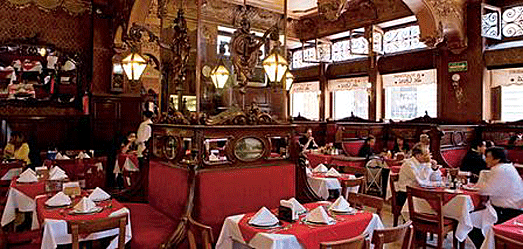
Ensconced in a soft red velvet upholstered booth, surrounded by rich
baroque-style paneling and mementos of an earlier day, I felt the
spirits of generals, politicians, and singers who frequented the bar in
its heyday. Singers and patrons would come down to the bar after the
opera at the Bellas Artes and locals would sing along to famous arias.
My waiter pointed to a bullet hole in the ceiling above me. It seems
Pancho Villa, happy that the revolution overthrew Porfirio Diaz, rode
into the bar on his horse and fired a shot into the ceiling.
The Palacio de Bellas Artes or Palace of Fine Arts just up the street is
Mexico City’s premier opera house. Noted for both its extravagant Beaux
Arts exterior, covered in imported Italian Carrara white marble, and its
murals by Diego Rivera, Rufino Tamayo, David Alfaro Siqueiros, and José
Clemente Orozco, it’s a showplace even today.
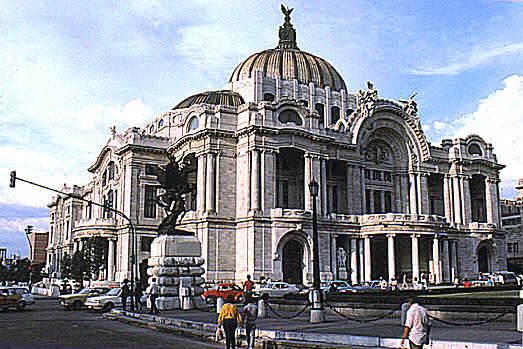
The Bellas Artes is a true expression of the Porfiriada, the 30-year
period in the late 19th and early 20th century when dictator Porfirio
Diaz ruled the country with an iron hand. Initially conceived as the
National Theater and a superior example of turn-of-the-century
eclecticism, it’s heavily influenced by the Art Nouveau style. Diaz fell
in love with Victorian style through his close association and
friendship with Queen Victoria of England. He wanted his country to be
as sophisticated as Europe and imitated its art, style, and customs.
Following this, he ordered plans for a new Teatro Nacional or National
Theater laid out by Italian architect Adamo Boari using state-of-the-art
technology. Construction of the new building began on October 1, 1904.
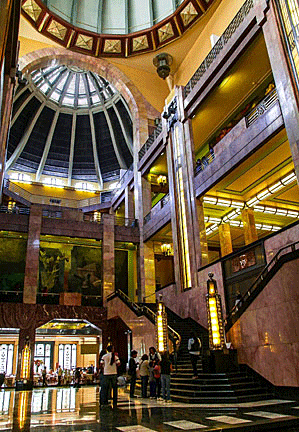 But
although construction began in 1904 and Boari scheduled its completion
by 1908, it languished due to the political struggles within the Mexico
and problems with Mexico City's muddy soil–the entire city stands on an
old lake bed—which led to the gradual subsidence of the building. Diaz,
himself, chose the construction site at one end of Alameda Park because
of its location at the center of the city’s financial and hotel
district. He wanted the building to face the tallest in the city while
still being next to an elegant park promenade. But Diaz’s choice of site
wasn’t good. Indeed, the weight of the building is so massive that it
has been sinking a few centimeters yearly since its completion. But
although construction began in 1904 and Boari scheduled its completion
by 1908, it languished due to the political struggles within the Mexico
and problems with Mexico City's muddy soil–the entire city stands on an
old lake bed—which led to the gradual subsidence of the building. Diaz,
himself, chose the construction site at one end of Alameda Park because
of its location at the center of the city’s financial and hotel
district. He wanted the building to face the tallest in the city while
still being next to an elegant park promenade. But Diaz’s choice of site
wasn’t good. Indeed, the weight of the building is so massive that it
has been sinking a few centimeters yearly since its completion.
The Mexican Revolution in 1910 further complicated the situation.
Frustrated at not being able to finish the project, Boari left Mexico in
1916 and construction virtually stopped until 1932, when work resumed
under Mexican architect Federico Mariscal, one of Boari’s students, who
completed the interior in 1934 using Art Deco motifs in 1934. Mariscal
enlisted the help of painter Diego Rivera, who had recently been fired
by the Rockefellers for a mural at Rockefeller Center that included an
image of Lenin.When Rivera refused to remove Lenin, Rockefeller
cancelled his commission and had the mural destroyed. So Rivera
repainted it a smaller scale at the Palacio and renamed it "Man,
Controller of the Universe."
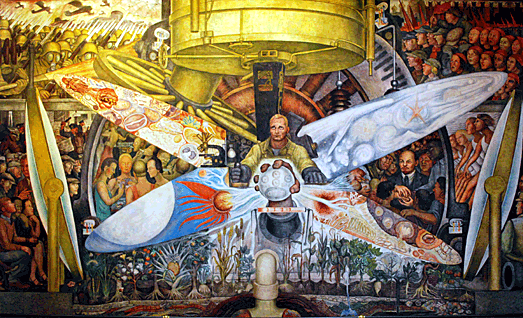
The works of some of Mexico’s most famous muralists—Diego Rivera, José
Clemente Orozco, and David Alfaro Siqueiros—grace the walls of the
Belles Artes’ lofty marble interior. Tiffany Studios of New York
designed the theater’s amazing stained-glass curtain depicting the
volcanoes surrounding the city. Today, the spectacular edifice is also
the home of the famous Ballet Folklorico and the Mexican Symphony and
Opera. The Mexican Government didn’t complete the square in front of the
Belles Artes, with its gardens and pegasus statues designed by Boari,
until 1994.
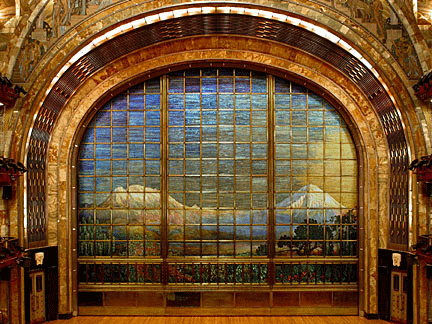 Today,
the theatre presents classical music, opera and dance, notably the "Baile
Folklórico". A distinctive feature of the theatre is its stained glass
curtain depicting a volcano and the valley of Mexico. It is the home of
Mexico's National Symphony Orchestra, the Bellas Artes Orchestra, the
Bellas Artes Chamber Orchestra, the National Dance Company, and the
Bellas Artes Opera. Today,
the theatre presents classical music, opera and dance, notably the "Baile
Folklórico". A distinctive feature of the theatre is its stained glass
curtain depicting a volcano and the valley of Mexico. It is the home of
Mexico's National Symphony Orchestra, the Bellas Artes Orchestra, the
Bellas Artes Chamber Orchestra, the National Dance Company, and the
Bellas Artes Opera.
Maria Callas sang in several productions at the Palacio early in her
career, and recordings exist of several of her performances here. Other
opera greats who have performed and/or sang there include Plácido
Domingo, Pavarotti, Kathleen Battle, Kiri Te Kanawa, and Jessye Norman.
Most of the world's great orchestras and dance companies have also
performed there, including the New York, Vienna, Israel, Moscow, London
and Royal Phiharmonics; the Philadelphia, Paris, Dresden Staatskapelle,
and the French, Spanish and Chinese National Orchestras; the Montreal
and Dallas Symphonies; the American Ballet Theatre, the English National
Ballet, the Australian National Ballet, the Bolshoi and Kirov Ballets;
among others.
Today, cleaned and restored, it’s bright white exterior gleaming in the
sun, its interior surfaces shining brightly, the Bellas Artes, is truly
a monument to the beauty of art.
<
Back to More Antiques to View
Next
Article > |
